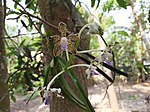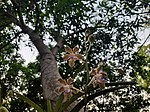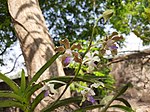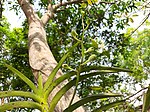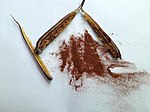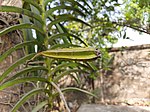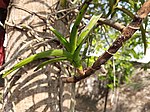Vanda tessellata
| Vanda tessellata | |
|---|---|

| |
| Scientific classification | |
| Kingdom: | Plantae |
| Clade: | Tracheophytes |
| Clade: | Angiosperms |
| Clade: | Monocots |
| Order: | Asparagales |
| Family: | Orchidaceae |
| Subfamily: | Epidendroideae |
| Genus: | Vanda |
| Species: | V. tessellata
|
| Binomial name | |
| Vanda tessellata (
G.Don | |
| Synonyms | |
Vanda tessellata (also known as Grey orchid
Description
It is an epiphytic perennial, stem 30–60 cm long, stout, scandent by the stout, simple or branching aerial roots. Leaves succulent, 15–20 cm, long, linear, recurved, complicate. Flowers in 6–10 flowered racemes, reaching with the peduncle 15–25 cm long. Sepals yellow, tessellated with brown lines and with white margins. Petals yellow with brown lines and white margins, shorter than the sepals. Lip 16 mm long, bluish, dotted with purple. Capsules 7.5–9 cm long, narrowly clavate-oblong with acute ribs.
-
Vanda tessellata (as syn. Vanda roxburghii) plate 506 in: The Botanical Register (Orchidaceae), vol. 6, (1820)
-
Vanda tessellata (as syn. Vanda roxburghii) plate 2245 in: Curtis's Bot. Magazine (Orchidaceae), vol. 48, (1821)
-
Vanda tessellata (as syn. Vanda roxburghii) Plate 59 in: R.Warner - B.S.Williams: The Orchid Album (1882-1897)
Medicinal uses
The roots are alexiteric and antipyretic; useful in dyspepsia, bronchitis, inflammations, piles and hiccup. Externally the root is used in rheumatism and allied disorders and diseases of the nervous system. It is also employed as a remedy for secondary syphilis and scorpion stings. The juice of the leaves is used topically in otitis and a paste of them finds use as a febrifuge. The roots possess significant anti-inflammatory activity.[4] and exhibit potent analgesic effects combined with a relatively low toxicity [5] A novel aphrodisiac compound ( 2,7,7-tri methyl bicyclo [2.2.1] heptane) has been found in the orchid in 2013.[6]
Chemical composition
The plant produces an alkaloid, a
Traditional practices
In the
Use as an entheogen in India
'Ayurvedic shamans' in India are said to have used the plant to induce 'the hypnotic narcosis of their office' leading to 'a transcendent state of being', having learnt originally of the intoxicating properties of this orchid by observing bees which had fed upon its nectar falling to the ground in a state of stupefaction.
Gallery
-
Vanda tessellata in Bangladesh
-
New buds of Vanda tessellata
-
Flowers of Vanda tessellata
-
Flowers in full bloom
-
Buds of Vanda tessellata
-
Young buds of Vanda tessellata
-
Matured fruit of Vanda tessellata
-
Seeds of Vanda tessellata
-
Seeds of Vanda tessellata
-
Fruit of Vanda tessellata
-
Transformation of Vanda tessellata flowers from buds
-
Vanda tessellata plant in a bamboo pot
-
Vanda tessellata plant
-
Vegetative reproduction of Vanda tessellata
References
- . Retrieved 11 May 2022.
- ^ "Vanda tessellata (Roxb.) Hook. ex G.Don". CITES Species+. Retrieved April 15, 2021.
- ^ Rao, Sankara; Swamy, Raja K; Kumar, Deepak; R., Arun Singh; Bhat, K. Gopalakrishna. "Vanda tessellata". Flora of peninsular India. Indian Institute of Science. Retrieved April 15, 2021.
- ^ a b Ghani, 2003
- PMID 26335564.
- ^ Rastogi & Mehrotra, 1990
- ^ Narcotic Plants (revised and enlarged second edition) ,Emboden,William,pub. Macmillan USA and Studio Vista UK 1979.
- ^ The Dictionary of Sacred and Magical Plants by Rätsch, Dr.Christian, pub. Prism Press, Bridport UK 1992.





